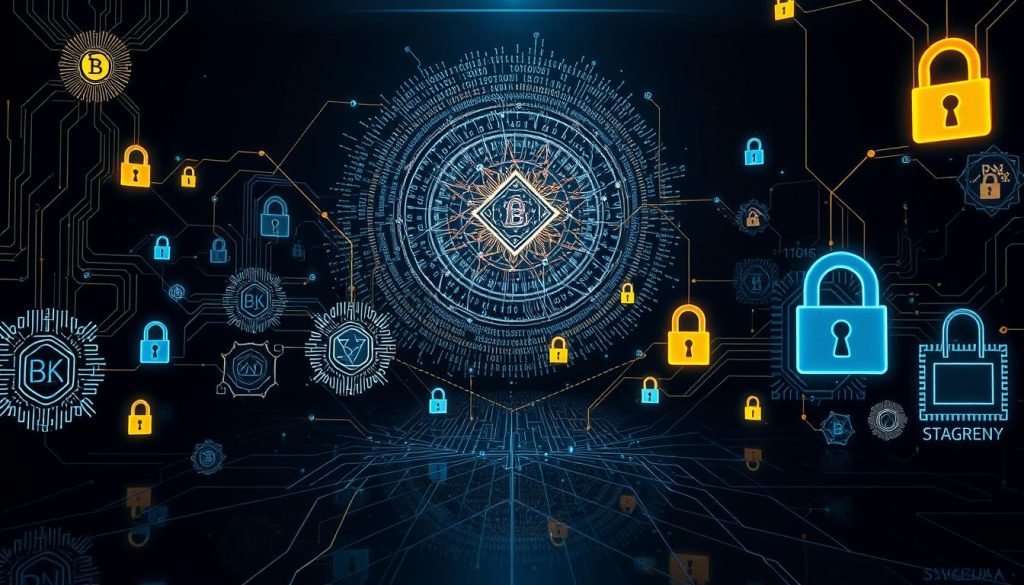Did you know 70% of the world’s central banks are looking into blockchain technology? This shows a big change in how we see money and deals. Blockchain is a system that makes transactions safe, clear, and quick. It’s all about using crypto to change the financial world.
Getting to know blockchain is key in today’s digital world. A good crypto explanation can guide you through this complex area. You’ll see how blockchain is used in many ways, like in money and supply chains. It’s a field that’s changing our lives and work, and it’s growing fast.
Key Takeaways
- Blockchain technology is a decentralized ledger system that enables secure and transparent transactions.
- The use of blockchain technology is being explored by 70% of the world’s central banks.
- Blockchain explained is a crucial aspect of understanding the power of crypto and its applications.
- Blockchain technology has the potential to disrupt traditional finance and transform the way we conduct business.
- A thorough crypto explanation is essential in understanding the complexities of blockchain technology.
- Blockchain technology is a rapidly evolving field with much promise for the future.
What is Blockchain Technology: A Simple Introduction
Exploring digital currency explanation means starting with blockchain basics. Blockchain is a system that makes transactions safe, open, and quick. It’s a way to keep track of deals without needing a single boss.
The crypto technology behind it uses many computers to check and save deals. This setup is spread out, so no one person controls it. It’s kept by a group of users. This makes it very safe, as changes are hard to make.
Blockchain isn’t just for digital currency explanation. It’s changing many fields, like finance and healthcare. It makes transactions safe and clear, which is why it’s getting more popular.
Understanding Distributed Ledger Technology
Distributed ledger tech is what blockchain is built on. It lets many people safely and openly keep track of deals. This tech could change how we do business, making it quicker, safer, and better.
The Building Blocks of Blockchain
Blockchain’s parts include computers, a shared ledger, and rules for adding deals. These pieces work together to make a safe and clear system. It’s hard to cheat or fake things.
Key Features of Blockchain Systems
Blockchain systems have important features. They are decentralized, secure, and open. Being spread out makes it safe, as changes are hard to make.
The History and Evolution of Blockchain
Exploring blockchain explained takes you back to its beginnings. It started with Bitcoin over a decade ago. Since then, blockchain has grown a lot, thanks to important milestones in cryptocurrency technology.
New cryptocurrencies have helped blockchain grow. They’ve brought new ideas, better security, and more room to grow. Now, blockchain is used in many areas, not just for money.
Blockchain is now used in finance, healthcare, and more. It’s known for being secure, open, and efficient. As you learn more about blockchain explained, you’ll see how it’s changing data management and cryptocurrency technology.
The story of blockchain shows the power of new ideas and working together. As it keeps getting better, it will change many parts of our lives. Knowing blockchain’s history helps you understand the fast-changing world of cryptocurrency technology and blockchain explained.
How Blockchain Technology Powers Cryptocurrency
Exploring cryptocurrency means understanding blockchain technology. A crypto explanation must cover the blockchain’s role. For blockchain for beginners, knowing how it supports secure and open transactions is key.
Blockchain’s core is a network of nodes and miners. They work together to check transactions and keep the blockchain safe. This is done through consensus, where all nodes agree on the blockchain’s state.
The Role of Nodes and Miners
Nodes verify and share transactions. Miners, with their powerful computers, solve complex math problems. This validates transactions and adds new blocks to the blockchain.
Understanding Consensus Mechanisms
Consensus mechanisms, like proof-of-work or proof-of-stake, keep the blockchain safe. They make sure all nodes agree on the blockchain’s state. This prevents attacks and keeps the network secure.
Transaction Verification Process
The process of verifying transactions is crucial in blockchain. It uses advanced cryptography and consensus to check transactions fast and securely. This makes the blockchain a vital part of the cryptocurrency world.
Blockchain Security and Cryptography
Exploring blockchain technology shows how crucial security is. The decentralized ledger system keeps transactions safe and sound. It’s a big reason why many industries are turning to it.
At the core of this security is blockchain technology. It uses special cryptography to guard your data. This makes sure no one can get in without permission.
The decentralized ledger system is all about being open and unchangeable. It lets users trust the network without needing a single boss. This is thanks to public-key cryptography and hash functions. They make sure data moves and stays safe.

The decentralized ledger system also means everything is clear and fair. Every transaction is written down for everyone to see. This makes it easy to check who has what.
This openness builds trust and keeps things running smoothly. As blockchain technology grows, it will likely become even more key in keeping data safe and open.
Real-World Applications Beyond Cryptocurrency
Blockchain technology goes beyond just cryptocurrency. Learning blockchain basics helps us see its uses in many fields. It makes things like finance and healthcare better by adding efficiency, transparency, and security.
Looking into blockchain explained shows us smart contracts and DeFi’s big role. These ideas can change how businesses work. They make deals quicker, cheaper, and safer.
Smart Contracts and DeFi
Smart contracts are key in blockchain. They automate many tasks, cutting out middlemen. This speeds up and lowers the cost of deals. DeFi also gives people more control over their money.
Supply Chain Management
Blockchain helps in supply chain management too. It makes tracking goods easier and safer. This way, companies can ensure their products are real and not fake.
Healthcare and Identity Management
In healthcare, blockchain keeps patient data safe. It makes sure only the right people can see it. It also helps in managing personal data, giving people more control over their info.
The Environmental Impact of Blockchain Technology
Exploring blockchain technology and crypto technology, we must think about the environment. Mining, key for validating transactions, uses a lot of energy. This has raised worries about blockchain’s carbon footprint and its environmental effects.
Mining’s energy use is huge, and we need to tackle this issue. Renewable energy sources can lessen blockchain’s carbon footprint, making it greener. Companies are looking into using solar, wind, and hydroelectric power for mining. This can greatly cut down environmental harm.

Also, researchers are creating energy-efficient algorithms to lower mining’s energy needs. This can be done with better hardware and software, and new ways to agree on transactions. By using these green blockchain solutions, the industry can lessen its environmental harm while still growing and innovating.
Energy Consumption in Mining
The energy needed for mining is a big worry, and we need to grasp the problem’s size. Blockchain and crypto technology have raised energy use, which can harm the environment badly. But, by switching to renewable energy and making mining more efficient, we can cut down on carbon emissions and support sustainability.
Sustainable Blockchain Solutions
For blockchain’s future, we need sustainable solutions. By being eco-friendly and cutting energy use, companies can lessen their environmental harm. Blockchain and crypto technology can change many industries, and it’s key that this change is green and responsible.
Common Challenges and Solutions in Blockchain Implementation
When you start exploring blockchain, you’ll face several hurdles. One big issue is the decentralized ledger system complexity. This can be tough for blockchain for beginners. To solve this, many companies are creating easy-to-use interfaces. These make working with blockchain simpler.
The regulatory environment is another big challenge. It’s still changing and can be unclear. This uncertainty makes it hard for businesses to follow the law. But, many groups are working to set clear rules for using blockchain. This will help reduce legal risks.
Despite these obstacles, solutions are emerging to help blockchain adoption. For instance, blockchain-as-a-service (BaaS) platforms are gaining popularity. They offer a secure and scalable way to use blockchain. This makes it easier and cheaper for more businesses to use blockchain.
As blockchain technology grows, making it easy to use is key. We need better interfaces and more training for blockchain for beginners. By tackling these challenges and finding new solutions, we can fully harness the decentralized ledger system. This will lead to a more secure, open, and efficient business world.
Conclusion: The Future of Blockchain and Its Global Impact
Blockchain technology is changing the game in many fields. It started with cryptocurrencies but now does so much more. It helps manage data securely and supports new ways of finance.
The future of blockchain technology looks very promising. It’s all about security, openness, and being decentralized. This means big changes in areas like supply chains, healthcare, and social projects. As more people use it, we’ll see new ways to solve big problems.
By now, you know a lot about blockchain explained. It’s an exciting field that’s growing fast. Keep up with new things, join in, and help shape the future. The future is looking bright, and there’s a lot to look forward to.





